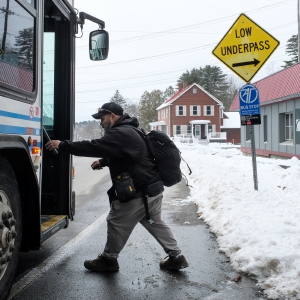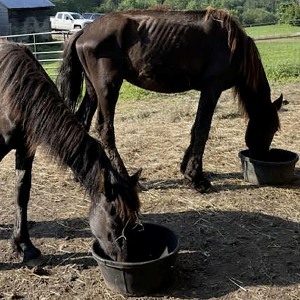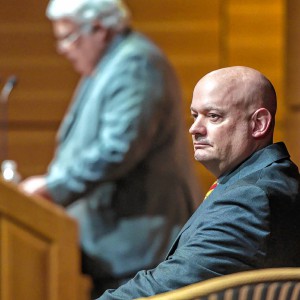With meat processors strained, advocates push for on-farm slaughter and sale
| Published: 12-18-2022 5:15 AM |
POMFRET — Tom Havill’s herd of cattle watched from a hillside as one of their own — secured in a holding pen — lost its life to a single shot fired by Chet Miller.
“Some of the cows run when they see my pants,” Miller said.
His yellow, waterproof coveralls, splattered with blood stains, are a dead giveaway to animals that have been raised for slaughter.
Miller is one of a handful of itinerant slaughterers in the Upper Valley. He travels from farm to farm, killing livestock for the owners’ personal consumption.
“I used to not be able to watch even this,” Havill said about the gutting, reappearing from his house after Miller had done the first part of his job. He still can’t watch the shooting.
It’s not easy for Miller, either. He’s had the job for more than 40 years, having learned from his own father, but he still has to take breaks.
“Once it’s down, I can process it in minutes,” Miller said.
But actually shooting the animal is another thing.
Article continues after...
Yesterday's Most Read Articles
 Upper Valley winter shelters kept dozens warm and dry
Upper Valley winter shelters kept dozens warm and dry
 Former principal of South Royalton School released from prison
Former principal of South Royalton School released from prison
 Owner of Friesian horse facility ordered to pay care costs for seized animals
Owner of Friesian horse facility ordered to pay care costs for seized animals
“You look an animal in the eyes, and sometimes they tell you, ‘I know what you’re going to do to me,’ ” he said. “It doesn’t get any easier.”
With the hardest part over at Havill’s farm, Miller and his co-worker, Kenny Bedell, hooked the carcass, which they had gutted, onto a tractor manned by Havill himself. He hoisted it up into the air when Miller gave him the go-ahead.
The trio worked together to get the dead animal ready for Havill to cart it to a slaughterhouse in the back of his pickup, where the meat will be cut and packaged. But per state regulations, Havill had no real hand in the actual slaughter.
While Miller and Bedell halved and quartered the hanging carcass with a power saw, up in the cab of the tractor Havill had his eyes turned away from the butchering of his cow, Jerry, and toward a cheerier picture.
“I had a calf Saturday,” Havill said, pointing to his herd up on the hill, and the small black smear springing behind its mother up by the treeline.
Miller, 65, is looking forward to soon retiring.
“I have nobody that wants my job,” he said. “It’s not a glorious occupation. I have a lot of people who appreciate me, and my calendar is full of people that need my help. But sometimes I wake up in the middle of the night, and what I’m doing lays heavy on me.”
Still, some are advocating that the service Miller offers farmers through his work — doing the difficult job, which many of his customers couldn’t do themselves, of killing the animal that they’ve raised — should be reconsidered as a tool toward a more versatile, modernized food economy.
A year ago, the U.S. Department of Agriculture refused Vermont’s request to allow meat from on-farm slaughters like Miller’s to be sold in small “animal shares,” which would operate like CSAs.
The restrictions on the practice yielded to the status quo: Any meat procured through on-farm slaughter can only be consumed by the owner of the animal or a small circle of their neighbors and the like. It can’t be sold commercially.
But before the refusal, and with renewed force since, Rural Vermont, a Montpelier-based nonprofit focused on bolstering community-scale agriculture, has continued advocating that the rules be relaxed so consumers and farmers alike have more choices.
The number of cows and pigs that are raised for meat doubled in the past 10 years, according to Vermont Public. The increased demand for local meat when the pandemic hit, which overburdened slaughterhouses, has remained steady as well.
Supporters of the changes argue that they could ameliorate supply chain issues that are caused by, and then make more difficult, an increasingly conscientious base of meat eaters.
“People are feeling that the need for more resilient food systems has become apparent,” said Caroline Gordon, Rural Vermont’s legislative director. “The trust and transparency of our current economic system was called into question during the pandemic.”
On-farm slaughtered meat allowed to be sold as a product, even within a small market, could alleviate some of the stresses on the slaughterhouses, some of which are booked up for many months, Gordon said.
But Vermont’s state meat inspection program, which has “equal to status,” meaning it can operate as a substitute for USDA inspection, is essential to a functioning meat supply chain. It could be jeopardized if the state guidelines were found to be not in compliance with federal rules.
” ‘Equal to’ is a small program, but it’s growing every year, and we really get a lot of outreach to people,” the state’s meat inspection chief, Julie Boisvert, said.
There’s already a shortage of USDA inspectors, so losing the state’s capacity to inspect would cause a major issue in an industry already strapped for manpower, she added.
Rural Vermont had a victory when it successfully agitated for doubling the cap the state had placed on how many animals could be slaughtered on farm, without inspection, annually. Now farmers can slaughter up to 80 sheep, 40 swine and 10 cattle.
Still, those animals are only for consumption by their owners.
The cap was instituted in the first place, Gordon said, to prevent on-farm slaughter from becoming “a commercial avenue.” But it’s up against “an increasing number of customers who take responsibility for stepping back into relationship with land and farmers and who want to get back in touch with processes like slaughtering.”
The attitude is increasingly necessary to resolve an aggressive demand for local meat, supporters of expanded on-farm slaughter allowances say. More broadly, they grease the wheels for a changing economic model, one that fosters local, diversified markets.
But in this case, the drive of a return-to-the-land ethic trips over bureaucratic red tape.
The meat chain in Vermont runs on options. There are the on-farm slaughters, and then there is slaughtering in custom slaughter facilities — which are licensed and inspected by the Vermont Agency of Agriculture. Meat processed in a custom facility is stamped “not for sale” and will be returned to “the owner(s) of the livestock for their personal use, their employees and/or their non-paying guests,” the state guidance reads.
Meat that is processed under the watch of a USDA or state inspector can be sold.
What Miller slaughters, skins and halves and quarters, slaughterhouses like Sharon Beef, which does both custom and commercial processing, finish by cutting and packaging.
Sharon Beef does slaughtering on-site too, and manager Trevor Tabor performs on-farm slaughtering on the weekends.
Tabor has worked seven days a week since the end of August, and he has customers already booked for next fall. He lives in a house attached to the Sharon Beef building — which includes the “killing floor” as well as stables for live animals — with his daughter Charlie, an eighth grader at Sharon Academy.
Customers pay $900 to have their “beefs” slaughtered, cut and wrapped. Lambs, which Tabor said he’s seen more this year than ever before, are $100 for the entire process.
Customers also are welcome to show up unannounced at Sharon Beef. Even on a Thursday night after closing time, two cows were unloaded from an unscheduled tractor trailer, and Tabor and his co-worker, Adam Tousignant, had to riddle through how to fit the unexpected arrivals into their full schedules.
“We have an open-door policy,” Tabor said.
“Some people like to abuse it, though,” Tousignant added.
The animals that are brought in for commercial processing, like the two cows dropped off last-minute, will be slaughtered for resale, so the process has to be done with an inspector present. Custom slaughter, in which an animal could be killed on the farm or by Tabor, doesn’t require inspection.
While there are rules on when in the day Tabor and Tousignant could process a commercial order, that doesn’t apply to custom animals. Last week, Tabor said, he got to work on a custom job at 5:30 a.m. and worked clear through 5 p.m.
On a cow, the slaughterer has the space the size of a quarter to get a bullet into. On a lamb or a pig, it’s the size of a dime.
“If you shoot the animal and you miss, you can get shut down for improper handling of an animal,” Tabor said. An inspector, either from the federal level or from the state — qualified through Vermont’s “equal to” status — is on-site to make sure practices adhere to guidelines.
At slaughterhouses, the inspectors are required to have their own offices, and even bathrooms.
When Tousignant was laid up with COVID-19 a few weeks ago, the pair, and their third partner, Phil Vaigue, fell behind by 35 lambs and 10 pigs. They had to carve out two days from their almost impossibly tight schedule for the lambs and another for the pork slaughter.
“The easiest ones to shoot are lambs without horns,” Tabor said. “But some of them are so small they’re, like, jumping off the walls and doing 360s.”
Flighty, aggressive animals are hard for Tabor and Tousignant as the two-man crew on the slaughter floor. They’ve known each other since Tabor was a child.
One opens the door to get the animal into the shooting area. The other fires the gun. Tabor prefers to use a rifle, while Tousignant feels more comfortable with a captive bolt, which shoots a quarter-inch-diameter rod 6 inches into the animals’ heads.
“When you do this, you’ve got to really trust who you’re doing it with,” Tabor said.
This March will mark two decades of slaughtering work for Tabor. His first job was at the Royal Butcher in Braintree, Vt., when he was 15, and he’s been managing Sharon Beef for four years.
“When I took over, there were only seven regular customers,” he said. “Now we’re up to 70.”
The sharp increase in demand prompted a $1 million grant from USDA last year to go toward expanding the capacity of Vermont’s meat processing industry. Some of the federal money is set to be used to start a meat processing program at Vermont Technical College in Randolph, but staffing has proved a challenge.
Sharon Beef received $53,000 to build a smokehouse on their property, but when exactly they’ll be able to make it happen is a mystery. Without more hires, they simply don’t have the time.
“It’s really hard to find help right now,” Tabor said.
“How can I really press home to people that this isn’t like a factory, material-handler job?” he asked. “How do you explain what we do here? What you’ll experience? To train somebody, you’ve got to see if they can handle being around it. We’ve had people who say they can do it, but then something will happen. It’s going to mess with you.”
Tabor wants to keep working as a slaughterer as long as he can, even with an inherent risk of injury. He said he’s OK with losing a finger. Just so long as it’s not on his bowling hand.
In the front office at Sharon Beef, a mug that boasts “#1 Bowler” hangs on the wall, next to the closet full of the white smocks that the crew wears to butcher.
Tabor plays in a league every Monday.
“That’s my only real escape, is to go there for a night,” he said.
“When bowling’s not going on, I pretty much don’t leave this property.”
Mary Lake, an itinerant slaughterer like Miller, is teaching the next generation. When Miller walks away from his business, and other older butchers like him do the same, she wants to ensure that there will be replacements to step in.
She understands the need to alleviate the pressure faced on all ends of the meat processing system, including Tabor’s backlog at Sharon Beef, because she started out in a facility just like that one.
Her aim is also, in part, to rewrite the narrative surrounding slaughtering.
Lake, 38, took a job at Royal Butcher — where Tabor also trained — in her mid-20s without any previous experience in slaughtering.
She said that when people dropped their animals off at Royal, some would leave quickly, not caring to know what happened behind closed doors.
“But you do want to know, because it’s actually really cool and great,” Lake said. “The slaughterhouses that we have in Vermont are amazing, and we’re really fortunate to have these small, mostly family-run, inspected set-ups.”
Still, we need other options too, Lake said, referring to on-farm slaughter, “for our own flexibility as farmers, and also for the sake of capacity.”
Slaughter, for many farmers, was “kind of behind a curtain,” she said. “When I talked to other producers, the feeling I was getting was that it was this necessary evil of raising livestock.”
But she emphasized that it shouldn’t be this way.
After starting at Royal, Lake immediately liked, and quickly took to, the skills: being able to identify the animal parts, packing, running a knife, eventually learning how to do the slaughtering itself.
Lake quit working at the slaughterhouse when she decided to start a family, and began shearing again — and, ultimately, doing on-farm slaughter — full time. The mentality of slaughtering, she said, is like the sheep shearing she had been learning as a shepherd’s apprentice.
It’s a physically demanding job. “You have to be really strong, but also really gentle at the same time,” Lake said.
She tries to eat lots of calories and drink electrolytes. She slaughtered a number of times while she was pregnant. “Now that I’m not pregnant, I’m like, ‘This is easy,’ ” she said.
Lake sees the dispute about the rules for on-farm slaughter as part of a bigger conversation about “our freedoms and our rights to be able to feed ourselves and our community, and to be able to choose what food we buy,” she said.
“I really feel like producers and consumers should have the choice. Of doing what they need to do for their farm, or buying the meat that they want to buy for themselves and their families.”
Slaughtering skills are hard to teach, Lake said, echoing Tabor’s hiring issues. But she does it anyway, training an apprentice and hosting workshops through Rural Vermont, at which she’ll slaughter a few animals in the morning and then do a cutting demonstration. In the middle, the group breaks for lunch.
Lake puts energy into teaching in hopes that the skills don’t get lost. They’re crucial to keeping small-scale meat markets up and running.
There’s a hard — but humane — practicality in the way that Lake talks about her work. She makes it clear that being compassionate in the slaughtering of animals requires practicality, and vice versa.
“The pandemic showed us that we need more options,” Lake said. “We need different ways to get our animals processed, and feed our communities. It can’t all be inspected. I think there should be other pathways, too.”
The Vermont Department of Agriculture has been supportive, to the extent that it can be, of the fight to legitimize on-farm slaughter for commercial distribution, Lake said. Running the risk of losing “equal to” status has the state’s hands tied while it tries to best stabilize a system in flux.
“We’re up against federal laws that were written a long time ago, and I think they need to be rewritten,” Lake said.
“I almost feel like I should be the one to do that,” she added with a laugh.
Either way, she’s glad that people are even talking about how meat is made — or “grown,” as Lake says — in the first place: “It’s important for people to know that it’s not this horror show.”
Slaughterers can maintain life, too.
Miller once was called in the middle of the night by Nancy LaRowe, who started Hogwash Farm in Norwich and whom he normally butchered for. The vet had just left her barn, stumped by a ewe that couldn’t give birth.
The lambs could only come out through C-section, which required Miller’s job.
“I had to kill the mother,” he said.
But he saved two of the three lambs.
“I wiped ’em off, slapped ’em around a bit, and got a bottle into ’em,” he said.
“And they really did grow up to be healthy lambs.”
Frances Mize is a Report for America corps member. She can be reached at fmize@vnews.com or 603-727-3242.

 Over Easy: ‘A breakfast without a newspaper is a horse without a saddle’
Over Easy: ‘A breakfast without a newspaper is a horse without a saddle’ Lawsuit accuses Norwich University, former president of creating hostile environment, sex-based discrimination
Lawsuit accuses Norwich University, former president of creating hostile environment, sex-based discrimination In divided decision, Senate committee votes to recommend Zoie Saunders as education secretary
In divided decision, Senate committee votes to recommend Zoie Saunders as education secretary
